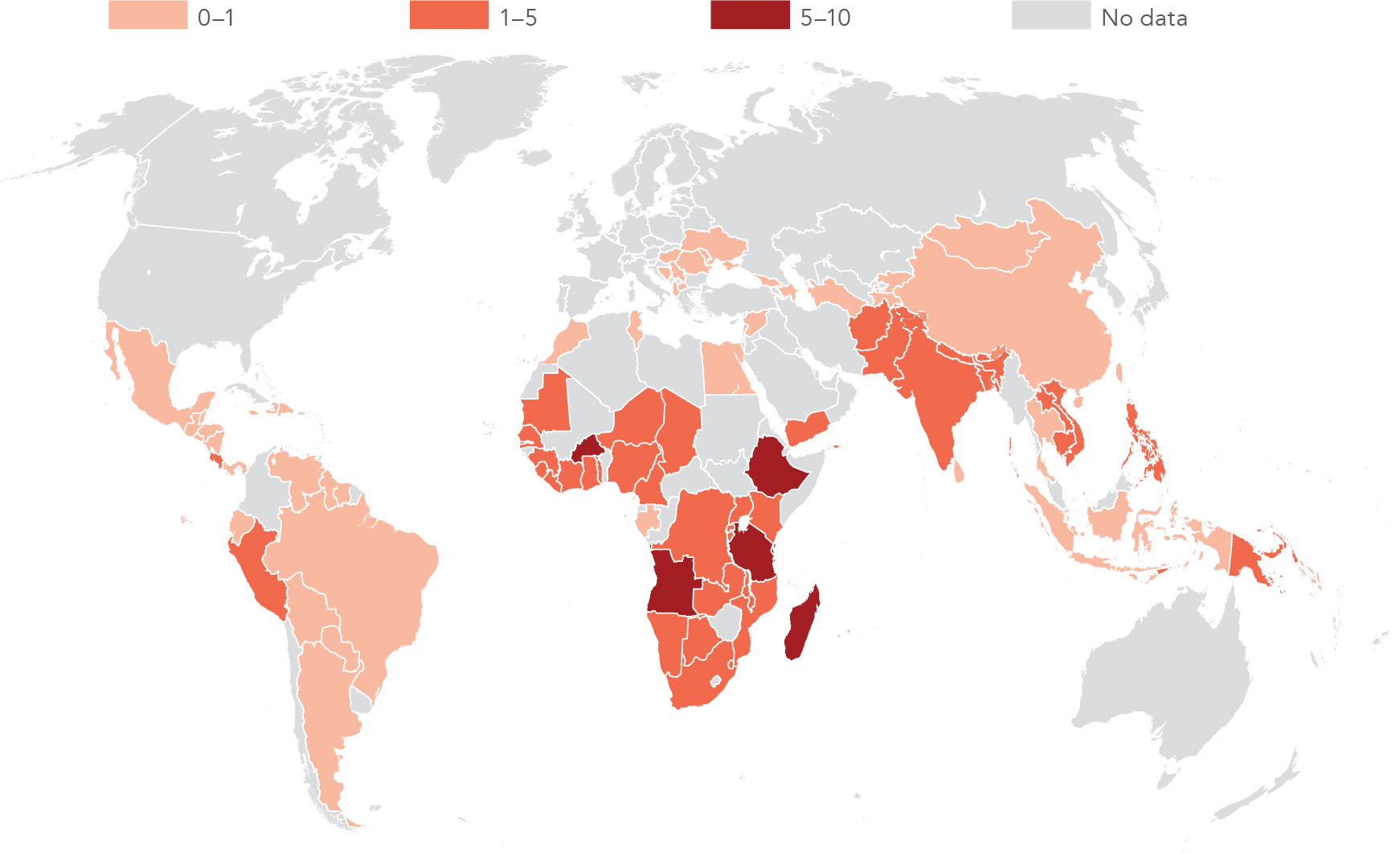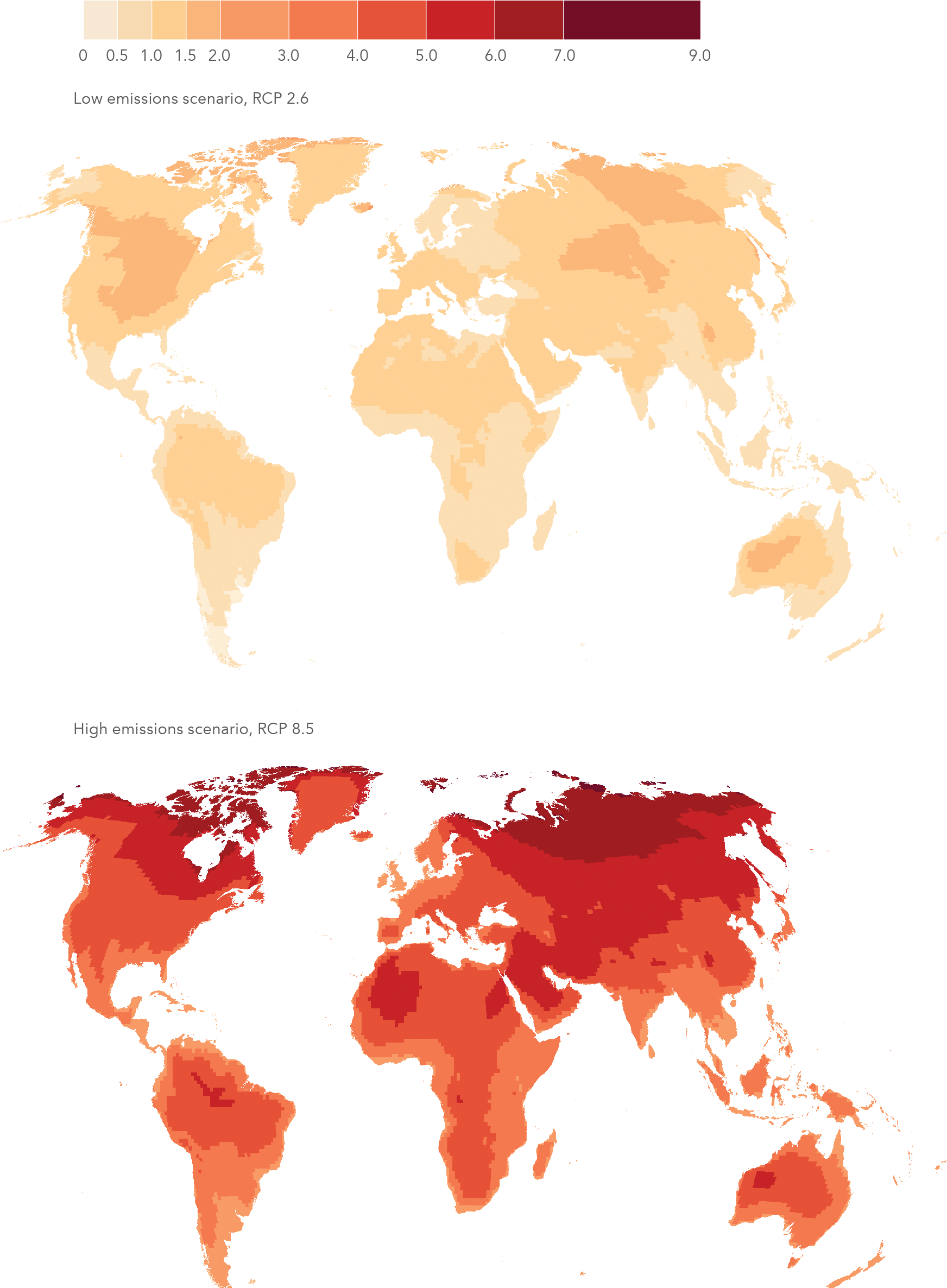Understanding the impacts of climate change
Global emissions of carbon dioxide, a major greenhouse gas (GHG) and driver of climate change, increased from 22.4 billion metric tons in 1990 to 35.8 billion in 2013, a rise of 60 percent (figure 13a). The increase in CO2 emissions and other greenhouse gases has contributed to a rise of about 0.8 degrees Celsius in mean global temperature above preindustrial times.
Continuing emissions of greenhouse gases will cause further warming and changes in all parts of the climate system.2 Climate change projections use scenarios that approximate levels of GHG buildup (translated as radiative forcing) in the atmosphere. In the lowest-emission scenario, models project a likely mean increase in global temperature of 1.0°C (±0.7°C) by 2100, relative to 1986–2005. The high-emission scenario models project a likely mean global temperature increase of 3.7°C (±1.1°C), with substantial regional variation under any scenario (figure 13d). Projected changes in annual precipitation also vary greatly depending on the scenario used (figure 13e). Extreme precipitation events over most of the mid-latitude land masses and wet tropical regions are likely to become more intense and more frequent by the end of the century. But under the high-emission scenario, mean annual precipitation is likely to decrease in many mid-latitude and subtropical dry regions.3
Given the lag between emissions reduction policies and their impact on global temperatures, an additional warming of at least 1 degree Celsius in the near future is inevitable; this could have a large impact on poverty reduction efforts.4 Recent analysis finds that climate change could push more than 100 million more people into poverty by 2030 (figure 13b).5 But good development—rapid, inclusive, and climate informed—can prevent most of the impacts of climate change on extreme poverty by 2030.
Goal 13 calls for stronger resilience and capacity to adapt to climate-related hazards and natural disasters. Climate change is expected to heighten the intensity of certain natural disasters, such as storms, hurricanes, cyclones, and flooding events. Historically, natural disasters have had a disproportionately adverse effect on low- and middle-income countries, both in the percentage of population affected and the relative loss of GDP (figure 13c). Small Island Developing States are particularly vulnerable, owing to their exposure to cyclones, their low elevation, and in some cases their economic vulnerability or lack of capacity. Given the expected increase in storm intensity attributable to climate change, these impacts could be even greater in the future.
Addressing climate change
Integrating climate change measures into national policies, strategies, and planning is critical (target 13.2). The December 2015 Paris Agreement under the United Nations Framework Convention on Climate Change (UNFCCC) aims to hold increases in the global average temperature to well below 2° C above preindustrial levels and to reach peak global greenhouse gas emissions as soon as possible with rapid reductions thereafter.
Parties to the UNFCCC have submitted nationally determined contributions (NDCs) detailing intended actions to address climate change. As of November 2016, 162 NDCs have been submitted by 189 countries. NDCs include measures to reduce greenhouse gas emissions (mitigation), better manage climate change impacts on socioeconomic systems and ecosystems (adaptation), and support national policies and planning (both mitigation and adaptation). They cover a wide range of sectors, including energy, agriculture, water, health, and disaster risk management (figure 13f).
Fifty countries' NDCs include cost estimates for implementation totaling US $5.1 trillion. Overall, 112 countries mentioned that they will require financial support for NDC implementation, 108 will require support for technology transfer, and 104 will require support for capacity building initiatives.
Financing the response to climate change
The UNFCCC established a goal of committing $100 billion a year by 2020 from developed countries to address the mitigation and adaptation needs of developing countries (target 13.a).6 In total, the OECD projects climate finance flows attributable to developed countries to be almost $93 billion in 2020, with around $67 billion from public sources, up from $43.5 billion in 2014. Export credits may account for an estimated $1.6 billion. The estimated contribution from private finance varies depending on underlying assumptions (figure 13g). Development is moving toward climate-resilient and low emission pathways in many low- and middle-income countries, enhanced by multilateral development bank commitments to increase support for climate change and disaster risk management.
Notes
- The United Nations Framework Convention on Climate Change is the primary international, intergovernmental forum for negotiating the global response to climate change.
-
Intergovernmental Panel on Climate Change. 2013. Climate Change 2013: The Physical Science Basis. Cambridge, UK: Cambridge University Press.
-
Intergovernmental Panel on Climate Change. 2013. Climate Change 2013: The Physical Science Basis: Summary for Policymakers. Cambridge, UK: Cambridge University Press.
- World Bank. 2012. Turn Down the Heat: Why a 4°C Warmer World Must Be Avoided. https://openknowledge.worldbank.org/handle/10986/11860.
- World Bank 2016. Shock Waves: Managing the Impacts of Climate Change on Poverty. Climate Change and Development. https://openknowledge.worldbank.org/handle/10986/22787. Several approaches are currently being used to estimate the climate finance provided to developing countries. While the multilateral development banks have developed their own agreed methodology, the Organisation for Economic Co‑operation and Development approach is presented here because it addresses a wider range of donor sources, and accounts only for contributions from developed countries.
- United Nations Framework Convention on Climate Change. 2010. "Report of the Conference of the Parties on its fifteenth session." http://unfccc.int/resource/docs/2009/cop15/eng/11a01.pdf.




